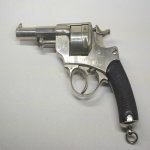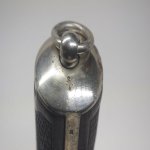One of the most satisfying aspects of collecting antique guns is the research, and sometimes the surprising results this research provides:
Recently I bought a French service revolver from a vendor of mine with the understanding that it was a Mle1873 navy model. These are quite a bit more rare than the regular army models, and are marked with various stamps to differentiate them. My vendor is a trusted source, so I had no reason to doubt his assessment. Soon after I had listed it on the website, a customer of mine who knows more about these than I (yes, it happens...) pointed out that mine may be a fake. The true navy model markings are slightly different from the one I had, and a website he referred me to suggested that there are some faked army models on the market, the faker trying to pass them off as navy models in order to get a higher price for them. The argument looked convincing however I doubt that someone would go through this much trouble to alter a relatively cheap revolver just to get a few hundred dollars more for it. The navy markings are crisp, and look very "official". It would take some expertise to make the dies and stamps to fake the navy anchor and the fonts. Since I did not know more (yet) I assumed the author of the article was correct and almost discounted the revolver as a fake. The issue did not leave me alone, though, and I had to do further research. My search brought me to a book by a French author describing French military pistols, and in it he writes that the French Navy did indeed purchase some 450 army revolvers from the arsenal (MAS), in the customary navy caliber of 12mm Lefaucheux. This was done during a transitional period, between the true navy models (ca. 1877) and the later adopted standard army models (ca.1886). The navy had always had its own administration and since they still used the Lefaucheux M1870 12mm center fire revolver and cartridge, the reasoning was that they only wanted one type and caliber of cartridge in order to avoid confusion. Thus the navy model, and then the modified army model. In the long run, the government decided that it was too expensive to have the arsenal make two different models of the Mle1873, and the navy had to concede. The 11mm Mle1873 became the new standard across all branches of the armed services after 1886 (to be replaced by the M1892 eventually). In short, the revolver I had on hand was one of the few Mle1873's which were specially ordered in 12mm Lefaucheux, stamped with the navy anchor and marked "M" (modified) and "L" (Lefaucheux cartridge). The serial number is a standard army number with letter prefix. So, what looked like a somewhat rare specimen and almost was labelled a fake, turned out to be an extremely rare variant, almost unknown to collectors!


Recently I bought a French service revolver from a vendor of mine with the understanding that it was a Mle1873 navy model. These are quite a bit more rare than the regular army models, and are marked with various stamps to differentiate them. My vendor is a trusted source, so I had no reason to doubt his assessment. Soon after I had listed it on the website, a customer of mine who knows more about these than I (yes, it happens...) pointed out that mine may be a fake. The true navy model markings are slightly different from the one I had, and a website he referred me to suggested that there are some faked army models on the market, the faker trying to pass them off as navy models in order to get a higher price for them. The argument looked convincing however I doubt that someone would go through this much trouble to alter a relatively cheap revolver just to get a few hundred dollars more for it. The navy markings are crisp, and look very "official". It would take some expertise to make the dies and stamps to fake the navy anchor and the fonts. Since I did not know more (yet) I assumed the author of the article was correct and almost discounted the revolver as a fake. The issue did not leave me alone, though, and I had to do further research. My search brought me to a book by a French author describing French military pistols, and in it he writes that the French Navy did indeed purchase some 450 army revolvers from the arsenal (MAS), in the customary navy caliber of 12mm Lefaucheux. This was done during a transitional period, between the true navy models (ca. 1877) and the later adopted standard army models (ca.1886). The navy had always had its own administration and since they still used the Lefaucheux M1870 12mm center fire revolver and cartridge, the reasoning was that they only wanted one type and caliber of cartridge in order to avoid confusion. Thus the navy model, and then the modified army model. In the long run, the government decided that it was too expensive to have the arsenal make two different models of the Mle1873, and the navy had to concede. The 11mm Mle1873 became the new standard across all branches of the armed services after 1886 (to be replaced by the M1892 eventually). In short, the revolver I had on hand was one of the few Mle1873's which were specially ordered in 12mm Lefaucheux, stamped with the navy anchor and marked "M" (modified) and "L" (Lefaucheux cartridge). The serial number is a standard army number with letter prefix. So, what looked like a somewhat rare specimen and almost was labelled a fake, turned out to be an extremely rare variant, almost unknown to collectors!














































































